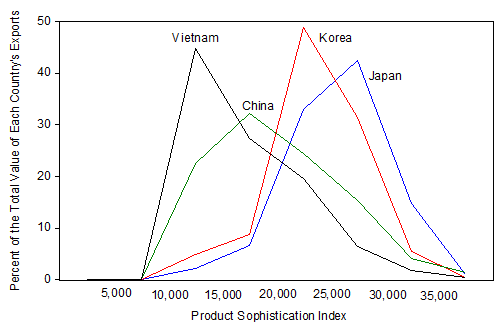| Author Name | THORBECKE, Willem (Senior Fellow, RIETI)/Hao-Kai PAI (Research Assistant, RIETI) |
|---|---|
| Research Project | East Asian Production Networks and Global Imbalances |
| Download / Links |
This Non Technical Summary does not constitute part of the above-captioned Discussion Paper but has been prepared for the purpose of providing a bold outline of the paper, based on findings from the analysis for the paper and focusing primarily on their implications for policy. For details of the analysis, read the captioned Discussion Paper. Views expressed in this Non Technical Summary are solely those of the individual author(s), and do not necessarily represent the views of the Research Institute of Economy, Trade and Industry (RIETI).
International Macroeconomics Program (FY2011-FY2015)
East Asian Production Network and Global Imbalances Project
Hausmann, Hwang, and Rodrik (2007) found that countries that export more sophisticated products tend to subsequently grow more rapidly. To measure sophistication, Hausmann, Hwang, and Rodrik (2007) and Kwan (2002) assumed that products exported by richer countries tend to be more technologically sophisticated. The logic behind this assumption is that goods exported by wealthy counties have higher labor costs. To compete in world markets, these goods need to be produced using more sophisticated technological processes.
We examine the sophistication of Asia's exports using Hausmann et al.'s and Kwan's measures. The results indicate that Japan was producing at the technology frontier in the 1980s and early 1990s, but has since fallen behind. It now produces capital intensive goods that are on average less sophisticated than those produced by countries such as Switzerland.
Japan's export basket nevertheless remains more sophisticated than those of South Korea and Taiwan. This largely reflects Japan's advantage in producing capital and equipment goods. The exports of Korea and Taiwan are in turn more sophisticated than those of China, Malaysia, the Philippines, and Thailand. The export baskets of these middle income countries are then more advanced by every measure than those of Indonesia, Vietnam, Cambodia, and Laos.
The figure below shows the sophistication of exports from Japan, Korea, China, and Vietnam. To keep the figure from appearing cluttered it does not include Taiwan, Thailand, Malaysia, or the Philippines. The results in the paper indicate that Taiwan's export sophistication level (CSI) is similar to Korea's and that the CSIs of Thailand, Malaysia, and the Philippines are close to China's. The figure makes clear that 1) Japan's exports are more sophisticated than Korea's (and by extension, Taiwan's), 2) Korea's exports are more sophisticated than China's (and by extension, Malaysia's, the Philippines's, and Thailand's), and 3) China's exports are more sophisticated than Vietnam's (and by extension, Cambodia's and Laos's). The figure also indicates there is significant overlap in export categories between Japan and Korea, Korea and China, and China and Vietnam, respectively. However, there is little overlap between Japan and Korea on the one hand and Vietnam on the other.
Results from the United Nations Conference on Trade and Development (UNCTAD) Merchandise Trade Correlation Index also indicate that, in 2012, Japan's exports competed with those of South Korea and Taiwan and were complimentary with those of China and ASEAN. South Korea and Taiwan competed intensely with each other but less so with China and ASEAN. ASEAN countries also competed extensively with each other.
Given the high levels of competition and cooperation among East Asian countries, greater exchange rate stability in the region would reduce export volatility among competitors such as Korea and Japan and facilitate trade among comrades such as advanced Asia and emerging Asia.
The results in the paper also indicate that policymakers in East Asia should not be complacent about the sophistication of their countries' exports. They need to improve their countries' human capital in order to foster innovation and climb the technological ladder. In addition, countries such as Indonesia, whose export basket is heavily concentrated in primary products, and Cambodia, whose basket is heavily concentrated in textiles, should seek to diversify the products that they export in order to promote more robust economic growth.
Figure: The Frequency of Japanese, Korean, Chinese, and Vietnamese Exports Based on the Sophistication of the Products Exported

(Note) The figure represents the share of each country's exports at different levels of product sophistication.
Product sophistication is calculated using the method of Kwan (2002).
(Source) CEPII-CHELEM database and calculations by the authors.

